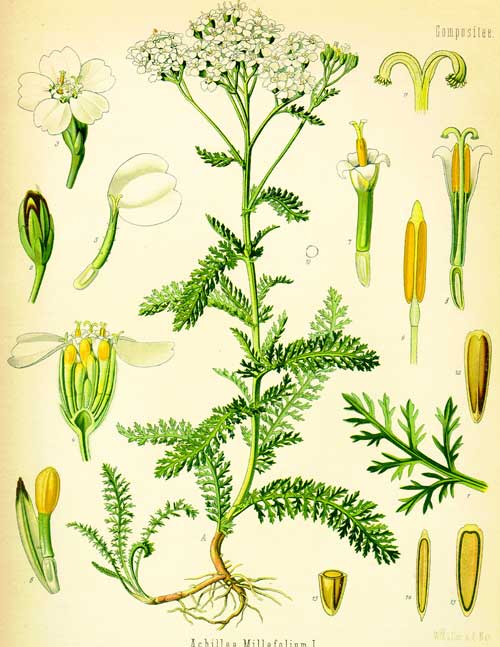
Yarrow, Achillea millefolium, a native of Europe, has adapted to the regions of North America and other moderate climates of our world. A member of the very large sunflower family, Asteraceae, it is quite closely related to wild and cultivated chamomiles.
A familiar wildflower, Yarrow’s mythical roots are often debated and are somewhat confused. The word “Achillea” refers to Achilles, an ancient hero. “Millefolium” means “coming of a thousand leaves”. This refers to the very small, fine and feathery leaves of this plant. The yarrow plant carries several other names: bloodwort, common yarrow, carpenter’s weed, knight’s milfoil, noble yarrow, old man’s pepper, nosebleed and staunchgrass.
There are many tales of how Yarrow became known as Achillea millefolium, however I have a fondness for the following tale as its often told in circle time at Herb Club to the capitivated faces of the young children.
Like most mythological heroes, Achilles had a complicated family tree. His father was Peleus, the mortal king of the Myrmidons–a people who, according to legend, were extraordinarily fearless and skilled soldiers. His mother was Thetis, a Nereid.
According to myths and stories, Thetis was extraordinarily concerned about her baby son’s mortality. She did everything she could to make him immortal: She burned him over a fire every night, then dressed his wounds with ambrosial ointment; and she dunked him into the River Styx, whose waters were said to confer the invulnerability of the gods. However, she gripped him tightly by the foot as she dipped him into the river–so tightly that the water never touched his heel. As a result, Achilles was invulnerable everywhere but there.
Achilles demise was a fatal arrow shot into his heel, bleeding to death. The richness and irony of this tale in relationship to Yarrow cannot be denied as this amazing herb holds such medicine for our blood system, wound heeling, plus so much more.
Yarrow is highly known and widely used in herbal medicines and delivered both externally and internally. The entire plant is used, both dried and fresh and is best when gathered while in flower. For culinary use the leaves of the yarrow can be used cooked or raw as wild, bitter ingredient in salads, soaps and steamed veggies.
The medicinal actions of Yarrow are vast including being anti-inflammatory, expectorant, diaphoretic, astringent, tonic, stimulant and mild aromatic.
- There is evidence of Yarrow’s use in Indigenous cultures for Native Americans wound care, infections and bleeding.
- Traditional Chinese Medicine includes Yarrow in formulas to aid the kidney, spleen, liver and energy channels throughout the body.
- Yarrow is an amazing uterine tonic, supporting the circulation in the uterus improving the tone and reducing spasms in the uterine.
- Yarrow improves digestive function through its bitter actions, improving bile flow and aiding in assimilation.
- In addition to slowing blood flow Yarrow has antiseptic action, cleaning the wound and aiding in it’s healing.
- Yarrow has both a drying and expectorant effect, useful as resolving coughs and sinus infections with sputum formation.
- Very helpful with allergies where nasal secretions and watery eyes are caused by moulds, dust, pollen and dander.
- Yarrow is also known to cause sweating in cases of flu, fevers and colds, helping to cure simple infections.
- Yarrow is used to aid in healing skin conditions, such as eczema.
- The pure essential oil extract of Yarrow is benefcial for anti-inflammatory actions.
Try this Yarrow recipe for a delicious summer soda that helps cool the body, decrease seasonal allergy symptoms and promote overall seasonal wellness!
YARROW SIMPLE SYRUP
Supplies needed:
1 cup fresh or dried aerial parts of Yarrow including the flower tops.
1 cup honey (you can use less if you prefer a less sweet syrup)
3 cups clean water
1 lemon, cut into slices
Optional spices such as cinnamon, ginger, clove, cardamom etc.
Clean bottle to package in
Brandy (optional)
Directions
- In a medium pot, add the Yarrow and the lemon slices and optional spices to the water and bring to a light boil with the lid on. Allow to simmer, very lightly, for only 1 minute. Turn off the heat and let the mixture infuse for 3 hours with the lid on.
- After 3 hours have passed, strain out the lemons and flowers. Measure the liquid you have remaining. Traditionally syrup is one part liquid to one part sweetener. For some, this may be too sweet. Use your judgement and add the appropriate amount of honey to your liking. Heat the mixture slightly to infuse the honey and tea.
- Completely cool the mixture prior to bottling. Honey acts as a mild preservative giving this syrup a shelf life in the fridge of about 30 – 50 days. By adding 20% by volume of alcohol you create shelf stable syrup with a shelf life of 1 year. Brandy is quite lovely as an addition to this syrup.
Uses
- Add 1 tablespoon of this syrup to sparking water as a delicious summer beverage. Also can be added to lemonade or iced tea.
- Add 1 teaspoon of the syrup to a hot cup of peppermint and elderflower tea during times of fevers.
- Add 1 teaspoon to a hot cup of mullein tea to help encourage expectoration during times of respiratory infection.
- Add 1 teaspoon of the syrup to a cool tea of lavender, chamomile or lemon balm to help cool and calm the nerves and relax the body.
Enjoy the season and the delights that Mother Nature has to offer. Happy Solstice everyone!!





